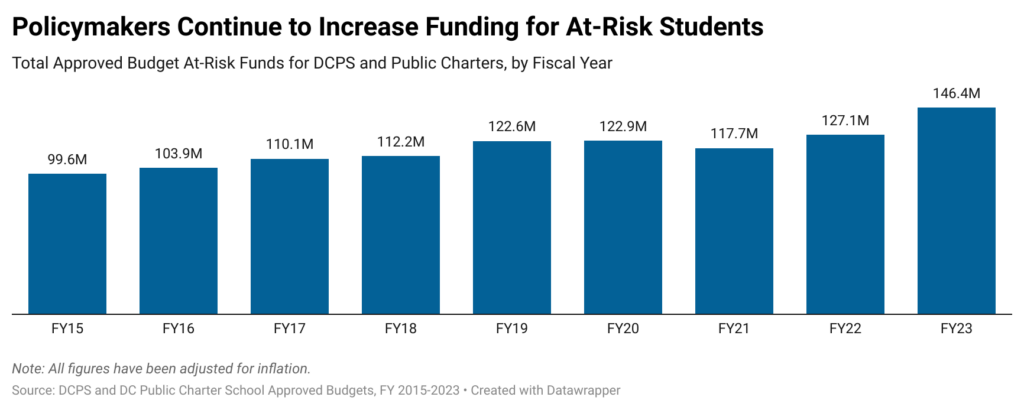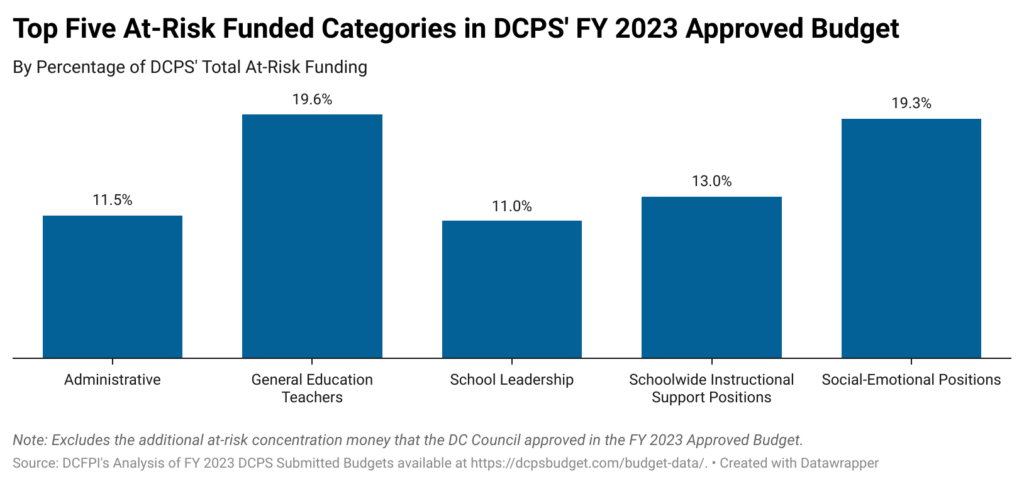Chairman Mendelson and members of the Committee, thank you for the opportunity to testify. My name is Qubilah Huddleston, and I am a Senior Policy Analyst at the DC Fiscal Policy Institute (DCFPI). DCFPI is a non-profit organization that shapes racially-just tax, budget, and policy decisions by centering Black and brown communities in our research and analysis, community partnerships, and advocacy efforts to advance an antiracist, equitable future.
DCFPI has long researched and testified about the need for both the District and DC Public Schools (DCPS) to engage in less opaque and more sound budgeting processes—such as developing a current services budget for public schools to accurately estimate how much it truly costs to provide a high-quality education to all of DC’s children.[1]
DCFPI appreciates Chairman Mendelson’s intent to address the unstable and unpredictable process and outcomes of DCPS budgets through this legislation. Specifically, DCFPI supports:
- Requiring DCPS to increase school budgets by inflation year over year so that schools do not lose buying power.
- Requiring DCPS to increase school budgets to cover costs that the agency transfers to schools that were previously covered by the central office, schoolwide, or school support accounts.
- Limiting the instances in which DCPS could justifiably decrease a school’s funding for full-time classroom teachers. (DCFPI recommends that the bill also include protections for classroom and schoolwide positions such as behavior technicians and computer lab teachers—positions that help promote positive school climates and enhance students’ learning experiences.)
However, DCFPI remains concerned that the bill may not achieve the stability the Chairman and DC residents desire. The bill fails to address key structural issues that DCFPI and many other advocates have raised before the DC Council, including:
- The need to replace one-time recovery funds that schools are using to cover needed and recurring positions.
- The financial viability of the continuous opening of new DPCS and public charter schools despite stagnating, and in some cases, declining enrollment in the District.[2]
- The Council’s ongoing failure to enforce the law that requires DCPS to “supplement, not supplant” school budgets with funding for “at-risk” students.
DCFPI strongly urges the Chairman and the Committee to prioritize additional policy and budget solutions that will make school budgets adequate and more equitable as well as define a unified vision for public education in the District.
Mayor and Council Will Need to Replace One-Time Funds Invested in Ongoing School Needs to Ensure Stability and Avoid Cuts
The fiscal year (FY) 2023 approved budget includes significant one-time federal and local funding to hold school budgets harmless against the projected enrollment declines that would have negative effects on school budgets and to help schools invest in pandemic recovery strategies in both DCPS and the public charter schools.
The Mayor has committed to providing another round of one-time pandemic recovery funding in FY 2024 but has not made an additional commitment to guard against further harm that DCPS enrollment declines will have on school budgets. Further, Federal Elementary and Secondary Schools Emergency Relief (ESSER) dollars expire at the end of FY 2024. However, in the last budget cycle, schools have budgeted ESSER and other one-time funds to pay for recurring expenses, such as classroom aides and other general education positions, that schools will need beyond pandemic recovery. This reality reflects policymakers’ need to right size DCPS’ budget so that it can both adequately fund general education services and equitably provide additional resources to students facing the steepest barriers to learning.
If the goal is to ensure school budget stability and avoid cuts as enrollment fluctuates, the Council will need to provide additional funding. If policymakers fail to permanently replace these funds, DCPS will likely be forced to make cuts in other key areas of the agency’s budget. Such cuts could lead to DCPS reducing important services such as curriculum development, food services, rent, and utilities—services that are more adequately and equitably provided through the agency’s central office and school support accounts.
DCFPI supports stable and predictable school budgets but is concerned that if the Council passes this legislation without a concurrent plan for sustaining needed resources and services made possible by vital one-time funds, the DCPS budget will be squeezed in ways that are destabilizing and harmful to children. DCFPI urges policymakers to proactively plan for the long-term sustainability of ESSER and other one-time investments to adequately meet the urgent and ongoing needs of students, families, and educators.
Declining Enrollment and Unchecked School Growth Are Root Causes of Unstable School Budgets
Budgeting models and processes only partly contribute to instability in school budgets. Declining enrollment is one of several root causes of school budget instability. DCPS primarily funds schools based on the number of students that the Deputy Mayor for Education (DME) projects will enroll at each DC public school. The DME projected enrollment declines in every ward except Ward 5 for FY 2023. The DME projected the largest enrollment declines in schools in Wards 7 and 8—DC’s Blackest and lowest income communities.
The District and DCPS have policies that attempt to protect schools from losing too much funding year-to-year. The DC law requires DCPS to fund schools no less than 95 percent of their previous year’s budget. DCPS’ new budget model includes a “safety net,” which is a “supplement…provided to schools when the student-based funds do not generate enough dollars to provide a baseline service by school type.”[3]
These policies are important, yet they do not solve for the fact that by-right, neighborhood schools –namely those with high percentages of students designated “at-risk” of academic failure—continue to experience enrollment declines year after year. In addition, they do not address the fact that DC has been experiencing a declining birth rate since 2016, which could lead to fewer children enrolled in schools overall.[4] These policies also do not address the fact that despite there being 35,665 unfilled seats last school year, DCPS and public charter LEAs continue to open new schools.[5]
DC has too many schools and not enough students, a reality unaddressed by the proposed legislation. And it is the schools who are serving students facing the steepest barriers to learning that are harmed the most by seemingly unfettered school growth in the District. The District’s seemingly “choice only” approach and disregard for the students who, due to choice or chance, attend their neighborhood schools, undermines educational equity. Is a high-quality, well-resourced school only available to those students lucky enough to get their school of choice in the lottery? Do students attending neighborhood schools not deserve the same quality of education?
If the Council wants to meaningfully address school budget stability, policymakers should articulate and adopt a more unified vision of public education so that resources are both adequate and equitable for all students no matter the sector.
Structural “Isms” Have Placed Many Students “At-Risk,” and the District is Failing These Students
It is past time for policymakers to make good on the promises of at-risk funding. Seven years ago, the Council implemented these funds to support students designated “at-risk” of academic failure, many of whom are Black and brown students and students from families and communities that face economic divestment, occupational segregation, environmental racism, over-policing, and other structural harms. Despite DC law requiring DCPS to supplement, not supplant school budgets with at-risk funding, the school system has never complied. And, while the law does not subject public charter local education agencies (LEAs) to the same law (even though it should), there has been a lack of uniform oversight of and transparency about how public charter LEAs are leveraging their at-risk dollars to meet students’ needs.
Policymakers continue to approve annual budgets that provide more at-risk funding to DCPS and public charter schools. They should provide a concurrent level of oversight to ensure that LEAs are budgeting these funds according to the law and in ways that match the purpose and intent of at-risk funding (Figure 1).

Policymakers’ failure to conduct robust oversight and the lack of efficient education data systems means that the District is unable to determine the relationship between at-risk investments and student outcomes. This is alarming considering DC taxpayers have funded $1.1 billion in at-risk funding since policymakers implemented the at-risk weight in FY 2015. In FY 2023, DCPS allocated their at-risk funding across 13 different categories, ranging from classroom teachers to administrative positions to non-personnel costs. Forty percent of DCPS’ total at-risk allocation are for classroom teachers and social-emotional positions with the remaining top five categories consisting of administrative, school leadership, and schoolwide instructional support positions, according to DCFPI’s analysis (Figure 2).

How individual schools budgeted at-risk dollars in FY 2023 varies significantly by ward, with schools in some wards allocating more of their funding toward costs that appear to fit the purpose of at-risk funding while others are more questionable. And given the lack of transparency of schools’ at-risk strategies, it is challenging for the public to understand how spending at-risk dollars on administrative or school leadership costs might be a worthwhile investment to improve outcomes for students designated at-risk.
DCFPI urges DCPS and public charter LEAs to provide more guidance to school leaders to support them in identifying effective strategies to boost student outcomes. DCFPI also urges the Council to use its oversight power to ensure that LEAs are spending at-risk dollars according to the law and intent of the funds.
Thank you for the opportunity to testify and I am happy to answer questions.
[1] Qubilah Huddleston, “Raising the Bar: Budgeting for a Strong Public Education System,” DC Fiscal Policy Institute, December 17, 2019
[2] Perry Stein, “D.C. school enrollment expected to drop after years of increases,” The Washington Post, July 13, 2022.
[3] DCPS, “Stability Funding,” DCPS.
[4] Deputy Mayor for Education, “After Years of Growth, Births Across DC Have Been Declining since 2016,” Edsight, May 2022.
[5] Deputy Mayor for Education, “Chapter 3 – Public School Facilities,” EdScape.
